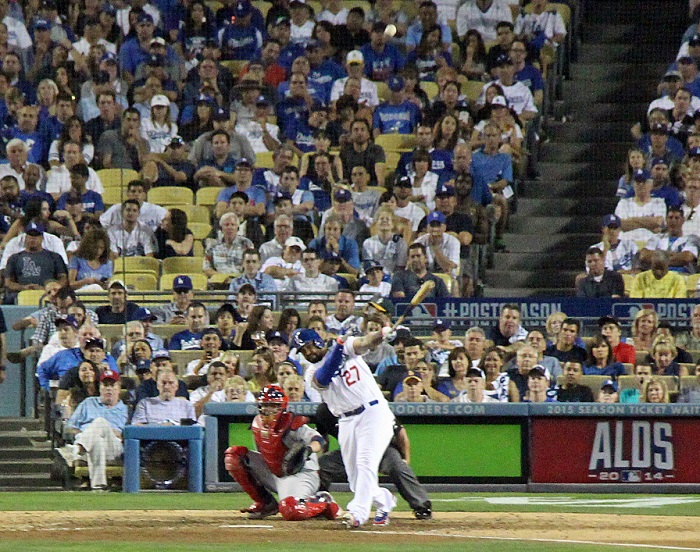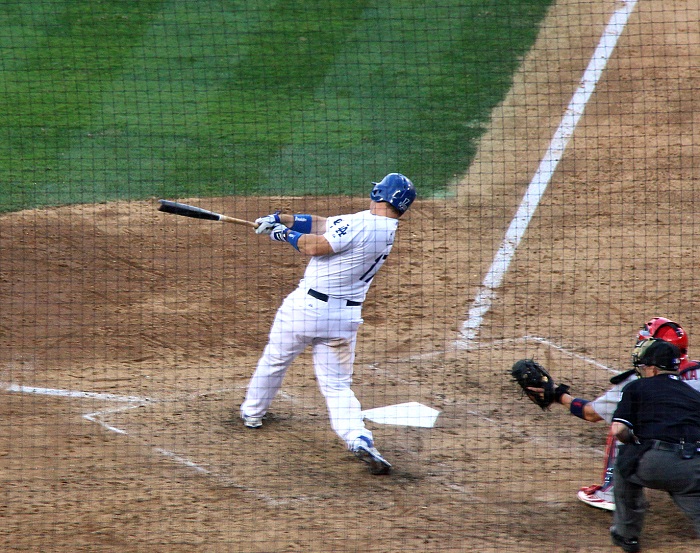When the Dodgers traded Matt Kemp to the Padres last month, they did so for several reasons – one of which made perfect sense, one a little sense and one absolutely no sense whatsoever.
The reason that made perfect sense is that sending Kemp to the Padres, along with $32 million cash, actually saved the Dodgers $75 million of the $107 million they sill owed him from his initial eight-year/$160 million contract.

Although losing Matt Kemp is a huge blow to the Dodgers offense, Andrew Friedman and Farhan Zaidi do not see it as an insurmountable loss. (Photo credit – Ron Cervenka)
The reason that made a little sense is that the Dodgers received a 26-year-old switch-hitting catcher in Yasmani Grandal in exchange for a 30-year-old right-handed only hitting outfielder.
And of course the reason that made absolutely no sense whatsoever is that along with losing Hanley Ramirez to free agency, the Dodgers traded away their second best right-handed power hitter who not only has 182 home runs in his nine-year MLB career, but also put up MVP-caliber numbers in the second half of the 2014 season for a catcher who has 24 home runs in his three-year MLB career and is an admitted PED user. Adding insult to injury the Dodgers also threw in 26-year-old back-up catcher Tim Federowicz in the deal. Now granted, Federowicz in nowhere near the offensive threat that Grandal might be, but Grandal is also not the defensive catcher that FedEx is – especially at blocking balls in the dirt.
So why, then, did Dodgers President of Baseball Operations Andrew Friedman make such a seemingly lopsided deal that clearly helped turn the once laughingstock Padres into the most formidable opponent in the NL West in 2015?
One reason – Farhan Zaidi – the Dodgers new general manager who came from Billy Beane’s Moneyball Oakland A’s. And unless you are an ardent A’s fan, you might not make the connection.
In 2014, under the direction and watchful eye of then Oakland A’s assistant general manager Farhan Zaidi, A’s manager Bob Melvin platooned catchers Derek Norris and John Jaso, and the results were amazing. The two backstops had a combined triple-slash of .267 / .349 / .415. And while Norris got most of the starts at catcher with 93 and earned a trip to Minneapolis for the 2014 All-Star Game, Jaso started 47 games behind the plate and was a very successful designated hitter the rest of the time.* Needless to say, Zaidi’s decision to platoon Norris and Jaso was a stroke of genius.
It’s impossible to argue that platooning Norris and Jaso – both of whom could have easily been an everyday catcher on just about any other MLB team – helped both of them exceed their career offensive numbers. I mean, why wouldn’t it? Their legs were fresher, they were often the designated hitter while the other was catching to stay sharp at the plate and they were both simply more well-rested than most everyday catchers.
To the surprise of many (and utter shock of A’s fans), Oakland traded Norris and minor-league right-hander Seth Streich to those same Padres on December 18 in exchange for right-handed pitchers Jesse Hahn and R.J. Alvarez, along with an international signing bonus slot. And then, just this past Saturday, the A’s traded Jaso and two minor leaguers to the Tampa Bay Rays in exchange for Yunel Escobar and Ben Zobrist – all of this, of course, occurring well after Zaidi had already left the A’s to become the Dodgers new GM.
When you start connecting the dots, you begin to wonder if Friedman and Zaidi acquired Grandal with the intention of pulling a Norris/Jaso-type platooning system with Grandal and soon-to-be 33-year-old veteran Dodgers catcher A.J. Ellis, or if it was done to simply replace the .242 career-hitting Ellis with a younger and potentially more powerful .245 career-switch-hitting Yasmani Grandal and make Ellis the Dodgers back-up catcher.
Another reason why the Dodgers may have gone after Grandal is because he will remain under team control through the 2015 season, which means he will make the MLB minimum of $507,500. He will, however, become arbitration-eligible next off-season and will probably see a substantial raise – especially if he has a good 2015 season.
On Tuesday, Ellis and the Dodgers agreed on a one-year/$4.25 million contract, thus avoiding arbitration – a $700,000 raise over the $3.55 million Ellis made during his injury-plagued 2014 season. But does this automatically guarantee that he will be the Dodgers opening day/every day catcher? Maybe; then again, maybe not. But even if Ellis becomes a back-up catcher to Grandal, there is one guy who is absolutely ecstatic that Ellis has been re-signed.
“I don’t know what I’m going to do if he’s not back,” said 2014 NL MVP and three-time Cy Young award winner Clayton last October. “I think we’d be losing a lot if we let him go. I know A.J. will land on his feet, but we need him here a lot. … Just the tireless work that he does, it’s so selfless. It’s invaluable to know that what he’s putting down, there’s so much thought, so much work behind it. It gives me confidence to throw it.”
Although Kershaw’s comments basically amounted to begging the Dodgers front office to bring Ellis back and regardless of whether or not this had anything to do with them re-signing Kershaw’s admitted best friend, how much playing time will the Cape Girardeau, Missouri native actually see in 2015? It’s certainly safe to assume that Ellis will at least catch Kershaw every fifth day, but will he see any more action than that or will he indeed become Grandal’s back-up and be lucky to play more than once a week?
This is where Zaidi’s platooning system may come into play and it’s hard to argue that it isn’t a brilliant plan. Although Ellis missed 69 games due to injuries in 2014, once completely healthy his bat came alive during the final month of the regular season and he was the Dodgers hottest hitter during their short-lived postseason. In his 17 plate appearances in the 2014 NLDS, Ellis was 7 for 13 (.538) with a home run, a double, two RBIs and four walks. His postseason on-base percentage was a ludicrous .647 and his slugging percentage .847 for an impossible 1.493 OPS. Unfortunately, and as we all so painfully know, Ellis was the only guy other than now former Dodgers Hanley Ramirez and Matt Kemp to hit above .300 in the Division Series.

Ellis’s home run in the fifth inning of Game-1 of the 2014 NLDS was one of only three that the Dodgers would hit in the series. (Photo credit – Ron Cervenka)
If Ellis can put up these kind of numbers while sitting out 69 games, albeit due to injuries, imagine what he might be able to do if he gets this kind of rest being platooned with Grandal when he is (hopefully) 100% healthy – and vice versa for Grandal.
Another factor that may come into play and perhaps is the real reason why the Dodgers acquired Grandal and why Zaidi’s platooning system might work exceptionally well with the pair is the fact that Ellis, a right-handed batter, hit left-handers better than right-handers in 2014, albeit only slightly and at a rather dismal .215 versus .183; whereas the switch-hitting Grandal hit right-handers (batting left-handed) better than lefties in 2014 at .241 versus .162 – a rather significant disparity. In fact, every one of Grandal’s 15 home runs in 2014 came off of a right-handed pitcher. Ellis, on the other hand, hit two of his three home runs in 2014 off of lefties. This alone may be cause for Grandal to get more starts than Ellis when the Dodgers are facing a right-handed starter.
The bottom line is that the Dodgers opening day and perhaps every day catching job will more than likely be determined on how well (or how poorly) Ellis and Grandal do during spring training – as it should be. However, don’t be surprised to see both of these guys splitting playing time behind the plate and probably relatively evenly in 2015. Should this happen and should both Ellis and Grandal put up decent offensive numbers during the season, Farhan Zaidi will once again have proven himself a genius.
(* Giovanni Soto made 14 starts and Stephen Vogt eight starts at catcher for the A’s in 2014)




 January 14th, 2015 at 6:00 am
January 14th, 2015 at 6:00 am  by Ron Cervenka
by Ron Cervenka  Posted in
Posted in 

RT @Think_BlueLA: New: Does Zaidi have something up his sleeve with Ellis and Grandal? – http://t.co/g5RCwrRS8l #Dodgers
Let’s hope it turns out for the best, whatever the best is.